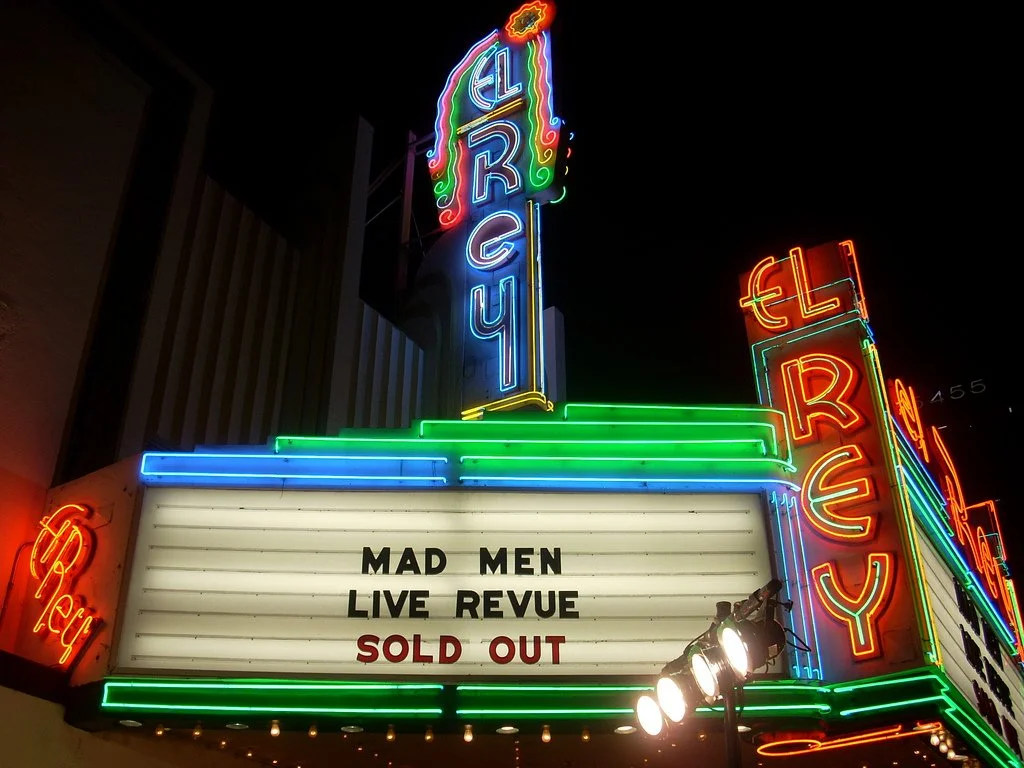El Rey Theatre: L.A.’s Art-Deco Gem That Became an Indie Powerhouse
Alt text: Exterior view of the El Rey Theatre marquee illuminated on Wilshire Boulevard at night.
Few venues capture the soul of Los Angeles’ music scene quite like the El Rey Theatre. With its glowing neon marquee and elegant Art Deco façade, the El Rey stands as both a time capsule and a launchpad — a place where local legends, indie acts, and global icons all converge before they make it big.
Tucked into the Miracle Mile district, the venue’s 900-person capacity ensures that every performance feels intimate, powerful, and unmistakably L.A. It’s a reminder that the city’s best shows often happen not in arenas, but in the small, storied rooms that pulse with history and energy.
A Theatre Reborn: From Silver Screen to Soundstage
Built in 1936 by architect Clifford A. Balch, the El Rey began life as a single-screen cinema, one of several jewels that dotted Wilshire Boulevard’s glamorous entertainment corridor. Its sweeping curves, ornate columns, and gilded lighting fixtures embodied the opulence of the Art Deco movement — a design style that defined the era’s most beloved theaters.
Through the 1940s and ’50s, the El Rey screened everything from major studio releases to independent features, eventually becoming part of the Fox West Coast and later Mann Theatres circuits. But as audiences shifted toward multiplexes in the 1970s and ’80s, the El Rey’s screen went dark.
By the late 1980s, the building’s fate hung in the balance. It briefly became a dance club called Wall Street, hosting late-night parties under its gold ceiling, but the original architecture was fading. Fortunately, preservationists stepped in. In 1991, the City of Los Angeles designated the El Rey a Historic-Cultural Monument (No. 520) — protecting its original Art Deco details from demolition.
A few years later, in 1994, the El Rey was reborn as a live performance venue. Managed by Goldenvoice / AEG Presents, the team behind Coachella and many of L.A.’s top venues, the El Rey began hosting concerts, comedy, and cultural events. Its transformation from cinema to concert house was complete — and the timing couldn’t have been better.
A Stage for Legends Before They Were Legends
If you scan the El Rey’s past lineups, it’s like flipping through a scrapbook of artists right before they broke through.
Billie Eilish performed there early in her rise, turning the small stage into a storm of whispers and shrieks as fans caught a glimpse of what was to come. Charli XCX played the El Rey before her stadium-sized pop sound took off, and LCD Soundsystem brought their signature blend of dance and angst to a room that could barely contain the energy.
Indie icons like Wilco, Pixies, and Interpol have all filled the venue’s gold-trimmed hall, while hip-hop legends Childish Gambino, Kendrick Lamar, and Ms. Lauryn Hill brought lyrically charged performances to its intimate stage.
It’s also a space where alt-pop and experimental acts have flourished — BØRNS, St. Vincent, Bonobo, and Hot Chip, to name a few, each made memorable appearances. One of the most charming aspects of the El Rey is how it captures these moments before the artists outgrow the space, as you’re often watching the last time they’ll play a 700-capacity room.
The venue has even found its way into pop culture itself. Scenes from Night of the Comet (1984) and Live at the El Rey — both the 2003 Stephen Lynch concert film and Mutemath’s 2006 live EP — showcase its cinematic bones and acoustic depth.
Alt text: Alt text: Rachel Platten at El Rey Theater, live performance.
Inside the Sound: A Modern System in a Vintage Shell
While the El Rey’s exterior still looks like a 1930s theatre, its sound system is cutting-edge. In 2015, 3G AV Installations completed a full overhaul of the venue’s audio setup, replacing an aging system with a state-of-the-art d&b audiotechnik rig built for modern touring acts (source: Live Design Online).
The new system features:
Five d&b Q1 loudspeakers per side for the main arrays
A d&b Q10 center fill
Four B2 subwoofers ground-stacked beneath the stage
D12 amplifiers powering the setup for precision and punch
The upgrade was installed in just three days while the venue’s calendar remained active — a testament to how in-demand the space is. The first shows post-upgrade drew rave reviews from artists and engineers alike.
Acoustically, the theatre retains the warmth of its movie-palace origins — plaster walls, tall ceilings, and reflective surfaces that make vocals shimmer without overpowering the mix. It’s a room built for clarity, not volume, which makes it ideal for genres ranging from synth-pop to soul.
Why the El Rey Still Matters
At a time when massive arenas and stadium tours dominate the music landscape, the El Rey Theatre continues to thrive by offering something far more unique — intimacy. With its curved floor plan and under-1000-person capacity, every spot in the room feels close to the action. Fans can lock eyes with the performer, catch every guitar riff, and feel the bass vibrate through the floor. It’s the kind of immersive live experience that larger venues often struggle to replicate, and it’s what keeps audiences coming back, decade after decade.
Part of what makes the El Rey so enduring is its programming. As a Goldenvoice / AEG Presents venue, it benefits from a curated roster that consistently blends discovery and prestige. Goldenvoice’s reputation for booking both established acts and rising stars ensures that the El Rey remains a proving ground for artists on the verge of breakout success. For many, playing the El Rey signals that they’ve made it onto Los Angeles’ cultural radar, an essential stop before the world catches on.
But beyond its booking power, the venue’s Art Deco aesthetic sets it apart from nearly every other performance space in the city. Red velvet curtains, mirrored walls, and gold leaf accents create a uniquely cinematic atmosphere that feels equal parts vintage and vibrant. It’s as if the ghosts of old Hollywood still linger in the corners, watching as the next generation of artists takes the stage. The design doesn’t just serve nostalgia; it actively enhances the experience, wrapping the crowd in a warm, glamorous glow that complements any genre of music.
The El Rey also doubles as a favorite space for live recordings and filmed performances. Its acoustics have been shaped by decades of cinematic design, lending themselves beautifully to capturing natural reverberation and crowd response. Musicians and production crews alike praise the room for the ability to translate energy from the stage to a recording, making it a top pick for intimate live sessions and concert films.
Finally, there’s a deeper cultural importance to the El Rey’s continued existence. In a city where redevelopment often overshadows preservation, the El Rey stands as a triumph of adaptation and preservation, a reminder that Los Angeles’ artistic past can still coexist with its creative future. Its protected historic status ensures that the building’s character remains intact, while its ongoing use as a music venue keeps it relevant and alive. Few places embody that balance as perfectly as the El Rey Theatre.
Alt text: Inside an intimate performance at El Rey Theater.
Recent & Upcoming Performances
Today, the El Rey remains an essential stop for rising stars and cult favorites. In just the past few years, it’s hosted everything from bedroom pop to metal, from indie rock to electronic crossovers.
Artists like BØRNS, The Japanese House, 070 Shake, and Bleachers have graced its stage in recent seasons. Its 2025 calendar features an eclectic mix with up-and-coming indie acts, producer showcases, and nostalgic throwback tours that pack the room wall-to-wall.
What’s remarkable is that despite changing trends, the El Rey has never lost its sense of discovery. It’s still the kind of venue where you can catch an artist on the verge — playing like their life depends on it.
Why Venues Like El Rey Matter for Music
In an era of streaming algorithms and social media discovery, small venues like El Rey continue to be the lifeblood of live music. They’re where artists hone their sound, connect with fans, and make the memories that no digital experience can replace.
For the musicians and engineers behind those shows, reliable gear is essential — from microphones and stage monitors to mixing consoles and flight cases. Companies that specialize in live production equipment help ensure venues like El Rey continue to deliver unforgettable performances night after night.
👉Explore professional-grade audio gear designed for live venues and touring artists at Echotone Music.
#ElReyTheatre #LosAngelesVenues #SmallMusicVenue #LiveMusic #ConcertVenues #IndieMusic #HistoricTheatres #ArtDecoArchitecture #Goldenvoice #AEGPresents



